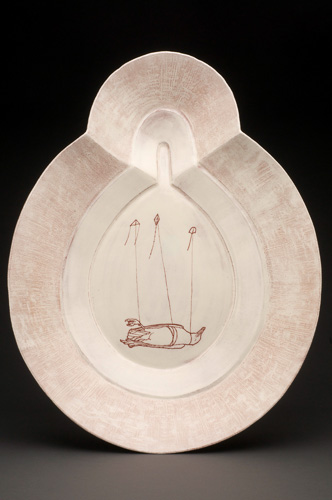
The concept embodied in a jar, a bowl, or any vessel for containment is, at its root, about generating a special place for something specific. The immediate connection someone has with a container regards its use. When we conjure an idea about using a container, we are practicing a basic ordering of our environment. By selecting a particular something to live inside that place, we act in harmony with our desire, as human beings, to recognize patterns and order in the world.
Drawn objects on my work act on the same principle as their parent vessels–a desire for order–but through a different avenue. Just as we are quick to create uses for a container, we are quick to create narratives when given a set of props. Entire, elaborate stories blossom nearly instantly in our minds from the simplest of starts. I am interested in acknowledging Order by offering a setting for it to occur in a vessel, and by recognizing it in our need for Story, developed through imagery.—David Eichelberger

and kites, earthenware, sgraffito,
3 x 19 x 12 inches
David Eichelberger
Form Focus
In the clay studio
In this workshop we’ll slow down and approach handbuilding in a way that will make every pinch count. Ideas will start with functional forms and grow from there. Techniques will include slab, coil, and pinching methods, bisque and plaster molds, and a variety of surfaces and finishes such as terra sigillata, sgraffito, and laser print decals. We’ll use earthenware clay and explore various firing possibilities. With the help of visiting artists and discussions, this studio immersion will be about ideas and how to realize them in clay. All levels, although some experience with wheelthrowing or handbuilding will be helpful.
In addition to simple laser-printed decals, students in David’s workshop will create, as a class, a silk-screened series of low-fire china paint decals in coordination with resources in Penland’s printmaking studio.
Students will also observe and pitch in, if they choose, on a slipcasting project generating molds and mugs led by David Eichelberger’s wife, artist Elisa Di Feo–but the main focus of Form Focus will be on handbuilding.
To find out more and register for this workshop click here.
Spring scholarship deadline is November 29.
Please note: applications need to be at Penland by this date to be considered for scholarship. Overnight service may not deliver to Penland’s campus on time, please plan accordingly.
David Eichelberger is a resident artist at Penland School of Crafts. He has taught workshops at the University of Nebraska-Lincoln and the Appalachian Center for Craft (TN) in addition to Penland. He has been a resident at Energy Xchange (NC) and the Appalachian Center for Craft. His exhibitions include Santa Fe Clay, Ferrin Gallery (MA), The Clay Studio (Philadelphia) and AKAR Design Gallery (IA), among others.
For the third time recently, David listened to the BBC program A History of the World in 100 Objects, and it continues to amaze him to think of how rich objects can be with information.

